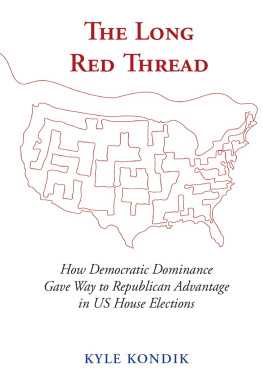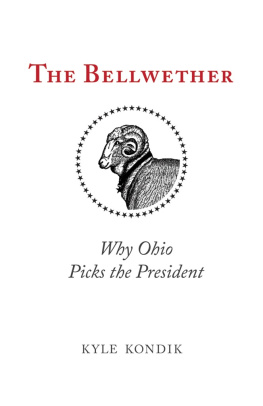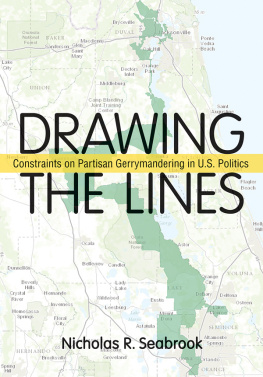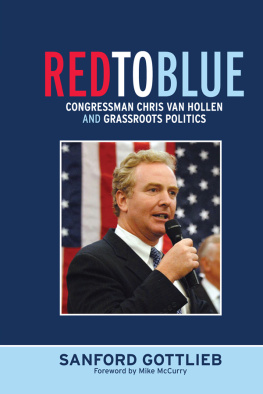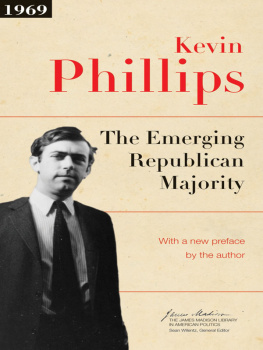Praise for THE LONG RED THREAD
Kyle Kondik has the rare ability to combine real-world mastery of politics with the erudition of political science research. In The Long Red Thread, he unspools a spritely and much-needed history of the last six decades of House elections as the chamber morphed from a safe and sleepy Democratic bastion to todays cauldron of hyper-nationalized politics.
Walter Shapiro, staff writer at the New Republic and Roll Call columnist
The Long Red Thread presents a detailed but concise account of the evolution of district-level voting patterns in congressional elections since 1964 that, among other things, deftly exposes the electoral roots of Congresss current susceptibility to stalemate and dysfunction. Anyone hoping to understand how American government arrived at its current unhappy state will find it illuminating.
Gary C. Jacobson, author of The Electoral Origins of Divided Government: Competition in U.S. House Elections, 19461988 and coauthor of The Politics of Congressional Elections
In The Long Red Thread, Kyle Kondik provides an in-depth analysis of an important trend that has largely been ignored by scholars: the long-term shift in competition in US House elections that has given Republicans a narrow but significant advantage. This book is a must-read for scholars and students of contemporary American electoral politics.
Alan I. Abramowitz, author of The Great Alignment: Race, Party Transformation, and the Rise of Donald Trump
Kyle Kondik is one of the brightest young stars in the firmament of election analysis, and his new book, The Long Red Thread, proves that anew. Kondik shows how Democrats lost their twentieth-century advantage in the critical process of redistricting, leaving Republicans with yet another arrow in their quiver for control of American politics. Kyles style, rich with colorful history and relevant detail, is sure to draw you in as he reveals some well-kept secrets of political power.
Larry J. Sabato, founding director of the University of Virginia Center for Politics and editor in chief of Sabatos Crystal Ball
Recounting more than a half-century of electoral history, Kyle Kondik documents how partisanship and electoral advantage can be amplified through reapportionment and redistricting practices. A crucially important story of how the House electoral map that once favored Democrats now tilts toward the GOP, The Long Red Thread is a must read for anyone seeking to understand the structures that affect electoral outcomes and determine our political futures.
Douglas B. Harris, coauthor of At War with Government: How Conservatives Weaponized Distrust from Goldwater to Trump
THE LONG RED THREAD
THE LONG RED THREAD
How Democratic Dominance Gave Way to Republican Advantage in US House Elections
KYLE KONDIK
Foreword by Douglas B. Harris
OHIO UNIVERSITY PRESS
ATHENS
Ohio University Press, Athens, Ohio 45701
ohioswallow.com
2021 by Ohio University Press
All rights reserved
To obtain permission to quote, reprint, or otherwise reproduce or distribute material from Ohio University Press publications, please contact our rights and permissions department at (740) 593-1154 or (740) 593-4536 (fax).
Cover design by Beth Pratt
Printed in the United States of America
Ohio University Press books are printed on acid-free paper
31 30 29 28 27 26 25 24 23 22 21 5 4 3 2 1
Library of Congress Cataloging-in-Publication Data
Names: Kondik, Kyle, author.
Title: The long red thread : how Democratic dominance gave way to Republican advantage in US House elections / Kyle Kondik ; foreword by Douglas B. Harris.
Description: Athens : Ohio University Press, 2021. | Includes bibliographical references and index.
Identifiers: LCCN 2021019577 (print) | LCCN 2021019578 (ebook) | ISBN 9780821424421 (paperback) | ISBN 9780821447345 (pdf)
Subjects: LCSH: United States. Congress. HouseElection districtsHistory. | United States. Congress. HouseElections. | Apportionment (Election law)United StatesHistory. | United StatesPolitics and government19451989. | United StatesPolitics and government1989
Classification: LCC JK1341 .K66 2021 (print) | LCC JK1341 (ebook) | DDC 324.973/092dc23
LC record available at https://lccn.loc.gov/2021019577
LC ebook record available at https://lccn.loc.gov/2021019578
To Lottie and Albie
CONTENTS
ILLUSTRATIONS
TABLES
FIGURES
FOREWORD
Over half a century ago, in a book called The Real Majority: An Extraordinary Examination of the American Electorate, Richard Scammon and Ben Wattenberg distinguished between pebble watching (a reference to the ancient Greek system of counting by pebbles, or psephos, in tabulating votes) and tide watching (the election watchers practice of accounting not just for individual vote choice but also for the electorate as a whole and for the partisan patterns that emerged from the decisions it rendered). To keep an eye on both the pebbles and the tides, election watchers, professionals, and rank amateurs alike, we must think in holistic ways that account for voters and the electorate, for parties and candidate campaigns, and for geography and the electoral maps that amplify some voters voices at the relative expense of others.
Its worth pointing out that watching electionsthe net gains of one party over the other in an election and over several succeeding electionsmatters more for democratic governance than the sport and excitement they can provide. As is frequently uttered in contemporary political commentary, elections have consequences. Astute election watchers thus have something important to tell us about the broader political system, the law, and public policy. To understand Americas policy future, one must understand its elections.
There are, to be sure, many books that watch the pebbles by tracking votes and opinions, but there are surprisingly few that keep an eye on the tides. But any quality election watcher knows that understanding elections and their outcomes demands attention to multiple elementsvoters, candidates, campaigns, and formal legal district and state boundariesthat are essential to interpreting election outcomes. Moreover, these elements of elections are products themselves of a constitutional legal framework as well as of decisions made by governing institutions, including the Supreme Court, which interprets the US Constitution and the law, the state legislatures that draw district lines, and even sometimes other institutions of government that shape the context in which election contests happen. To be sure, constitutional factors, such as the Senates apportionment disparities or the Electoral College, are more obvious in their impact on other institutions elections. But the House of Representatives, including its election outcomes and membership, is also a construct of the US Constitution and other institutional pressures that exist outside of its control. Indeed, not only are the Supreme Court and state legislatures critical actors in shaping the House, but the US Department of Justice, for example, also plays an important role in the story told in this book.
In The Long Red Thread, Kyle Kondik (himself a noted professional psephologist and tide watcher) tells the crucial history of how the House of Representatives electoral map went from tilting significantly in favor of the Democrats in the mid to late 20th century to having a (slightly less steep) tilt in favor of the GOP in the contemporary era. This is not to say that the Democrats cannot compete; they can, and they can win. Indeed, they won majorities in the recent 2018 and 2020 elections. Still, the Democrats compete at a disadvantage. The House electoral map favors Republicans. And just as election watchers should by now be well aware of the Republicans head start in the Electoral College and the decided advantages they enjoy due to the Senates apportionment magnifying the voice of those who live in less-populated (often Republican) states, the GOP has a clear advantage in the House as well. This is the crucial finding documented in this book.

